 A couple of months ago, I re-posted my “old” Easter Cookie Box, a tutorial I wrote two years ago. The idea was that the sides of the box would look like a fence that had its vertical planks replaced with Easter cookies. I was surprised to see how much love this box has still received after two years, and so I was inspired to create a summer version. The construction technique for this summer box is slightly different, though. On each side, there is only one beach-themed cookie holding together the wavy horizontal elements, and it is not simply glued to the flooded planks as was done with the Easter cookies on the Easter box. Instead, I glued it to two naked (un-iced) wavy cookies; then I flooded those wavy cookies, so that it was embedded in icing (about one-third the way up its sides). The outcome is a sturdier cookie box with a "lighter", lower profile design, although it is probably more difficult to take apart to eat.
A couple of months ago, I re-posted my “old” Easter Cookie Box, a tutorial I wrote two years ago. The idea was that the sides of the box would look like a fence that had its vertical planks replaced with Easter cookies. I was surprised to see how much love this box has still received after two years, and so I was inspired to create a summer version. The construction technique for this summer box is slightly different, though. On each side, there is only one beach-themed cookie holding together the wavy horizontal elements, and it is not simply glued to the flooded planks as was done with the Easter cookies on the Easter box. Instead, I glued it to two naked (un-iced) wavy cookies; then I flooded those wavy cookies, so that it was embedded in icing (about one-third the way up its sides). The outcome is a sturdier cookie box with a "lighter", lower profile design, although it is probably more difficult to take apart to eat.
- Cookie dough of your choice
- Sharp sugarcraft knife
- Cookie templates (See "Attachments" under "Files" at the end of this post.)
- 8 (10 x 3.4-cm/4 x 1 1/4-in) wavy cookie sticks, hand-cut using my templates
- 1 large (12.5-cm/5-in) square cookie, for box base (I used the largest cutter from this six-piece square cutter set.)
- 4 (2.5-cm/1-in) round cookies
- 4 mini beach-themed cookies, already baked and decorated (See Step 1 below for details.)
- 2 or more seagull royal icing transfers* (See "Attachments" for seagull templates.)
- Royal icing and pastry tips:
- Ivory flooding-consistency (PME #2 tip or equivalent)
- Brown very thick consistency (@Julia M. Usher calls it “glue” in her video, and I like to call it “Julia’s glue”.)
- White piping-consistency (PME #1 tip or equivalent)
- Navy and sky blue blue flooding-consistency (PME #2 tip or equivalent)
- Ivory medium-thick consistency (Wilton #3 tip or equivalent)
- Zester or Microplane tool
- Graph paper
- White gel food coloring
- Fine liner paint brush
- Silicone mat
- Tall (8-10 x 4-cm-tall/3 1/8-4 x 1 1/2-in-tall) square cookie cutter, for propping box sides
- Wide (1.2-cm/1/2-in) flat paint brush(es) (I used the one from this Wilton set.)
- Tea strainer or fine-mesh sieve
- Icing sugar (aka confectioner's sugar) tinted with ivory gel food coloring, for sand (Learn how to tint icing sugar in Steps 1a and 1b of my Felt Technique tutorial.)
*Note: A royal icing transfer is nothing more than icing piped on acetate or parchment paper that has been allowed to dry before transferring it to a cookie.
Step 1: Cut, bake, and prep cookies; also prep royal icing transfers
You will need a total of 17 cookies for this project. Some are hand-cut, and others are not. For the first 13 cookies pictured below, roll your dough to a thickness of about 0.6 centimeters (1/4 inch).
Cut, bake, and prep these 13 cookies according to these notes:
- 8 (10 x 3.4-cm/4 x 1 1/4-in) wavy cookie "sticks" for the horizontal elements of each box side. Use a sugarcraft knife to hand-cut them using my templates in the attachments at the end of this post.
- 1 (12.5-cm/5-in) square cookie for the base of the box. Cut, bake, and then flood it using ivory flooding-consistency royal icing and a PME #2 tip (or equivalent). Let the icing dry, and set the cookie aside for use in Step 3.
- 4 (2.5-cm/1-in) round cookies for the feet of the box.
You will also need the following mini cookies and royal icing transfers:
- 4 mini (2 to 5 x 4 to 5-cm/3/4 to 2 x 1 1/2 to 2-in) beach-themed cookies to connect the wavy cookies on each side of the box. For these cookies, roll your dough thinner to a thickness of 0.4 centimeters (3/16 inch). You will find the templates for the cookies I used in the attachments below, but any mini cookie in the size range indicated above will do. Once the cookies are baked and cool, decorate them in icing colors that coordinate with the sky blue and navy blue to be used on the wavy cookies. Since this tutorial focuses on this box's unique construction, I won't belabor the decorating of these cookies, but you will find some design inspiration in the photo immediately below.
- 2 seagull royal icing transfers for additional box side decorations. Again, you’ll find the templates in the attachments at the end of this post. You'll also find instructions for making royal icing transfers in Steps 5b to 5d of my previous First Day of School Cookie Sign tutorial.

Step 2: Miter cookie edges, and assemble and decorate box sides
a. Before decorating and assembling the sides of the box, miter each of the short edges of the 8 wavy cookies that form the 4 sides. By "mitering", I mean filing them to a 45-degree angle using a zester or Microplane tool. Mitering ensures that the sides of the box will fit more closely together at the corners, as I demonstrate in Step 2b, below. BTW, it took me a little more than 5 minutes to file all 8 cookies.
b. In the photo to the right (directly below), I highlighted the sides with the mitered edges with a green check. The red "X"s mark two other possible ways to assemble the sides (without any mitering), just to demonstrate the difference between corners with mitered and un-mitered edges. The red-"X" options aren't wrong; they just aren’t my favorite way to assemble 3-D cookie projects, because they often need some decorations to cover the seams, which can lead to "heavier" designs.
c. Now, arrange the wavy cookies in pairs on top of graph paper. The lines on the paper are great guides for making sure the cookies in each pair are parallel and at the same distance from one another (about 1.5 centimeters or 9/16 inch). They also make it easier to see if the cookies in a pair are aligned with the cookies in the next pair. Each pair is a side of the box and is about 7.5 centimeters (or 3 inches) tall, as measured from the bottom wave to the top wave.
d. Using brown very thick-consistency royal icing "glue", attach a decorated mini cookie to the center of each pair of wavy sticks. Let the icing dry completely.
e. Use white piping-consistency royal icing and a PME #1 tip (or equivalent) to outline all of the wavy cookies. Pipe a horizontal line through the center of the top cookie in each cookie pair.
f. Work on one pair of wavy cookies at a time. Use navy blue flooding-consistency royal icing and a PME #2 tip (or equivalent) to flood the bottom cookie and the bottom section of the top cookie in each pair. Immediately flood the top half of the top cookie using sky blue flooding-consistency royal icing and a PME #2 tip (or equivalent). By immediately flooding, the two sections should merge together seamlessly. Repeat this step to flood the remaining three cookie pairs. Let the icing dry completely.
Note: The flooding icing should come roughly one-third the way up the sides of the mini cookies on top. Surrounded as such with icing, the minis become integral to the sides and make for a very sturdy structure.
g. Now, it's time to add some details! Use white piping-consistency royal icing to glue a seagull transfer to the bottom cookie of the side with the seagull cookie. On each of the box sides, highlight the line where the sky and sea meet (i.e., between the sky blue and navy icing) using white gel food coloring and a fine liner paint brush. Then glue the other seagull royal icing transfer to the top cookie in the seagull side.
h. To add depth, paint clouds randomly on each sky blue section of each box side. Again, use white gel food coloring and the same liner paint brush used in the previous step.
i. Once again, use the fine liner paint brush and white gel food coloring to doodle some little wavy lines on the navy blue sections.
j. Now, use white piping-consistency royal icing and a PME #1 tip (or equivalent) to over-pipe half of each doodled line to highlight it.
Step 3: Assemble box
For this step, I recommend working on a silicone mat. It will not only serve to grip the cookies, but it will also reduce the chance of breakage if a cookie should fall or be dropped during the assembly process. I also recommend a tall square cutter (about 8 to 10 centimeters wide by 4 centimeters tall, or 3 1/8 to 4 by 1 1/2 inches) for propping the sides and ensuring they are perpendicular to one another.
a. Pipe brown icing glue on the inside mitered edges of one side. Also, pipe some white piping-consistency royal icing along the outer facing edge. This way, once the sides are assembled, you’ll end up with a white seam on the outer box corner and a brown seam on the inside corner.
b. Press the iced edge against the mitered edge of the adjacent box side, and prop the joined sides in an upright position using the square cutter. Smooth any excess white icing in the outer seam using a wide flat paint brush (or your clean fingertip). Repeat the same smoothing process on the inner seam, and let the icing dry.
Meanwhile, repeat Steps 3a and 3b for the other two sides. You will end up with two “L” cookies. Again, let the icing dry, and avoid moving the joined sides for a few hours.
c. Now, it's time to fill in the white box corners, so they more seamlessly blend into the sky blue and navy blue icing on the sides. Work on one "L" cookie (and its one seam) at a time. Thicken both the sky blue and navy blue icings to a thick flooding-consistency. Using a PME #2 tip (or equivalent), pipe sky blue icing into the top part of the seam so that it spans the sky blue areas on the box sides. Fill in the rest of the seam with navy blue icing.
d. Use a wide, flat paint brush to smooth the icing along the seam.
Repeat Steps 3c and 3d on the seam on the other "L" cookie. Once the icing is dry, you can even paint details (clouds, waves, etc.) over the seams to further disguise them.
e. Again, pipe some brown "glue" and some white piping-consistency royal icing along both mitered edges of one of the two “L” cookies, just like you did in Step 3a, and join the two "L"s together to form a complete box or "frame". Repeat Steps 3b to 3d for each of the two new corners. Set aside the box frame until the icing is completely dry. In the meantime, move on to assembling the box base and feet in the next step.
f. Lay the already-iced square cookie upside down on your work surface, and use brown "glue" to attach the four circle cookies to the underside for feet. These feet are not essential, but they will make it much easier to get your fingers under the base and to lift the assembled box. Now, turn the cookie right side up, and let the icing dry.
g. Using a PME #3 tip (or equivalent), randomly pipe ivory medium-thick consistency royal icing along the edges of the iced box base, filling in about 2 centimeters (3/4 inch) from the edge. The icing should be thick enough to keep its shape, yet thin/wet enough to be easily smoothed with a paint brush.
h. Use a wide flat paint brush to blend the icing and to shape it into shallow "sand dunes".
i. Use a tea strainer (or fine-mesh sieve) to sift the tinted ivory sugar onto the icing while it is still wet. Let the sugar sit for a couple of minutes.
j. Tap the cookie to remove the excess sugar, and center the frame on the sandy base while the icing is still wet.
Our cookie box is ready!
And now, some views from all angles . . .
As you know, I like to produce different variations of my cookie projects. Below is a version inspired by the Italian countryside, with fields of poppies, sunflowers, daisies, and lavender, and hills in the distance. Did you notice that I assembled the wavy sticks upside down so that they are now hilly?
If you made it to this point and are interested in more nautical-themed cookie project tutorials, here are the links to (and photos of) my past ones on Cookie Connection:
a. Made by Manu: Nautical Cookie Platter
b. Made by Manu: A Royal Icing Knot
c. Made by Manu: 3-D Beach Hut Cookie Box
Happy summer! ☀️🌊⛱🏄♀️
Manu


Photo and cookie credits: Manuela Pezzopane
Note: Made by Manu is a Cookie Connection blog feature written by Manuela Pezzopane, where each month she shares the method behind a magical cookie of her own making. This article expresses the views of the author, and not necessarily those of this site, its owners, its administrators, or its employees. To read all of Manuela's past Made by Manu tutorials, click here. And to see all of Cookie Connection's tutorials, click here.

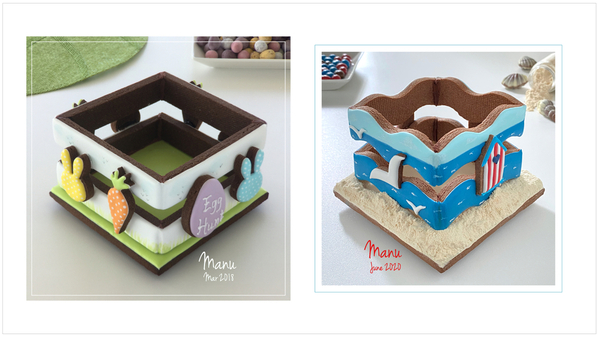
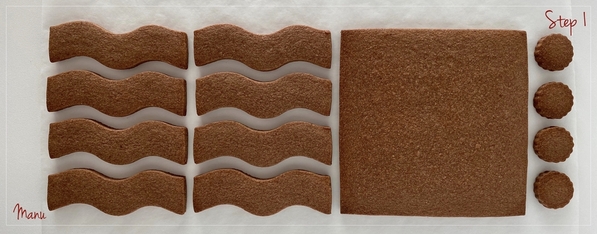
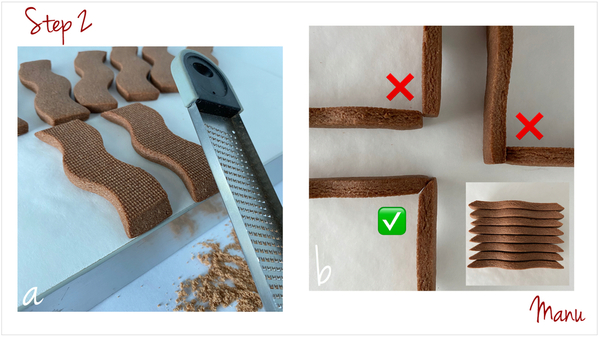


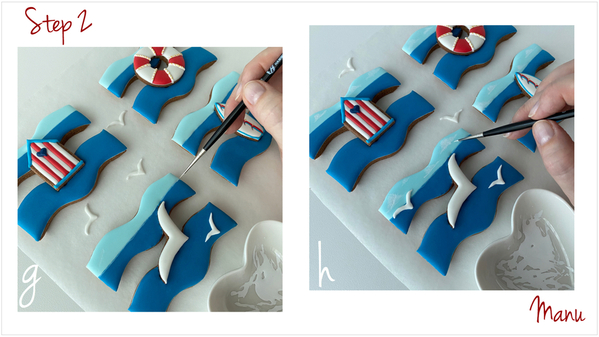
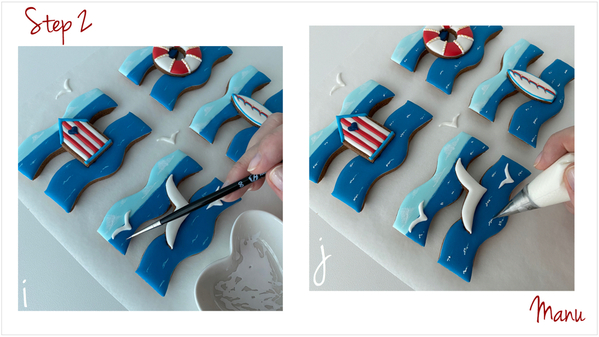
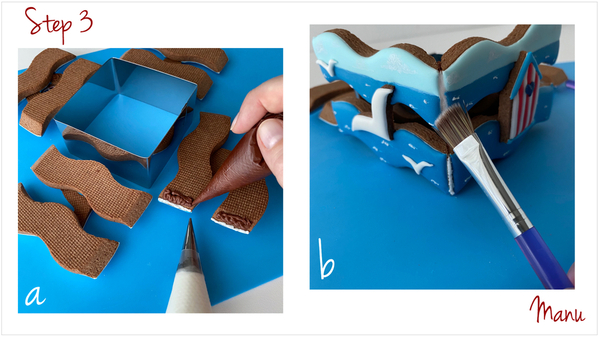




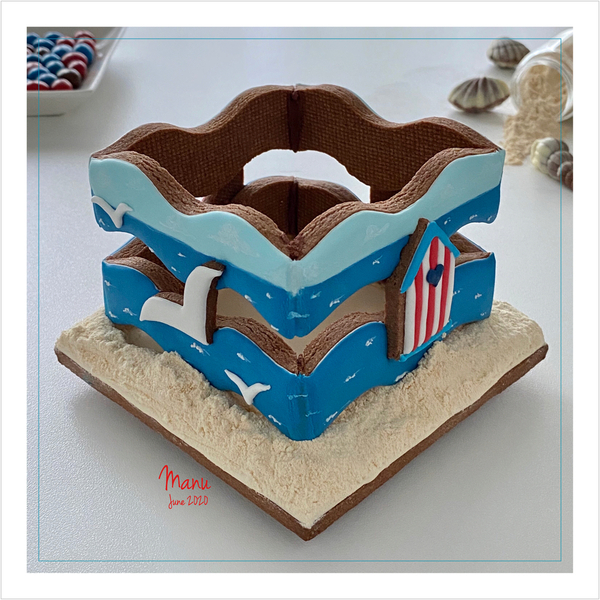

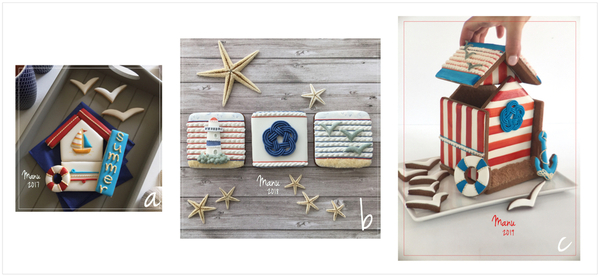



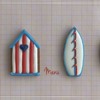

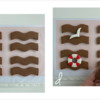





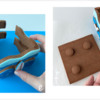

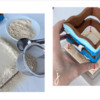

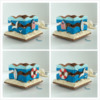


Comments (29)